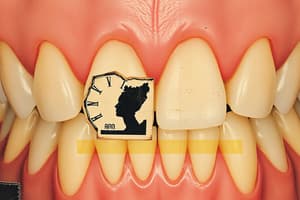Podcast
Questions and Answers
What is the primary preventive measure against gum disease?
What is the primary preventive measure against gum disease?
- Using mouthwash frequently
- Eating a healthy diet
- Avoiding sugary foods
- Practicing good dental hygiene daily (correct)
What is the purpose of scaling in treating gum disease?
What is the purpose of scaling in treating gum disease?
- To extract damaged teeth
- To remove hardened tartar above and below the gum line (correct)
- To apply sealants to the teeth
- To whiten the teeth
How often should one floss to help prevent gum disease?
How often should one floss to help prevent gum disease?
- Once a week
- Every other day
- Twice a day (correct)
- Three times a day
What might be recommended for more advanced cases of gum disease?
What might be recommended for more advanced cases of gum disease?
How do antibiotics play a role in treating gum disease?
How do antibiotics play a role in treating gum disease?
What does root planing involve in the treatment of gum disease?
What does root planing involve in the treatment of gum disease?
What is the specialized branch of dentistry focused on the prevention, diagnoses, treatment, and maintenance of diseases affecting the supporting structures of teeth?
What is the specialized branch of dentistry focused on the prevention, diagnoses, treatment, and maintenance of diseases affecting the supporting structures of teeth?
Which stage of gum disease is characterized by the formation of pockets between the teeth and gums due to tissue destruction?
Which stage of gum disease is characterized by the formation of pockets between the teeth and gums due to tissue destruction?
What symptom is commonly associated with gingivitis?
What symptom is commonly associated with gingivitis?
If left untreated, what can gingivitis progress into?
If left untreated, what can gingivitis progress into?
What happens in the final stage of advanced periodontal disease?
What happens in the final stage of advanced periodontal disease?
What is the main consequence of pockets forming between the teeth and gums in gum disease?
What is the main consequence of pockets forming between the teeth and gums in gum disease?
Flashcards are hidden until you start studying
Study Notes
Gum Disease and Periodontology
Periodontology is a specialized branch of dentistry focused on the prevention, diagnoses, treatment, and maintenance of diseases affecting the supporting structures of teeth—specifically, the periodontium. One major part of this field deals with gum disease, which can range from mild to severe depending on its stage and impact on oral health.
Stages of Gum Disease
Gum disease, also known as periodontal disease, has three main stages:
-
Gingivitis: This early stage affects only the gums. It occurs when plaque builds up along the gum line, causing redness, swelling, and bleeding during brushing, flossing, or eating. People may have gingivitis without even realizing it because these symptoms often go unnoticed by those who do not routinely examine their mouths closely. However, if left untreated, gingivitis can progress into more serious forms of gum disease.
-
Moderate to Advanced Periodontal Disease: When gingivitis worsens, it becomes moderate to advanced periodontal disease. At this point, pockets form between the teeth and gums due to tissue destruction from inflammation. These pockets allow food particles and bacteria to accumulate, leading to further infection and potential tooth loss.
-
Advanced Periodontal Disease: In its final stage, the disease causes the bone beneath the teeth to erode, making them loose and prone to falling out. Without proper intervention, such as scaling, root planing, and antibiotic therapy, patients could lose several teeth over time.
Prevention and Treatment
The primary preventive measure against gum disease involves practicing good dental hygiene daily. This means regularly brushing your teeth twice a day using fluoride toothpaste and ensuring thorough cleaning of all surfaces, including back teeth. Additionally, you should floss once per day to remove plaque and debris from areas where your brush cannot reach effectively. Regular dental checkups every six months are essential for professional cleanings and examinations necessary to catch signs of gum disease before it advances too far.
Early treatment for gingivitis might involve non-surgical procedures such as scaling and root planning. Scaling removes hardened tartar above and below the gum line; meanwhile, root planing smoothes rough spots on roots where germs gather and helps reattach the gums around the teeth. Antibiotics may also play a role in treating gum disease and reducing pocket depth. For more advanced cases, surgical treatments like gum grafts or flap surgery might be recommended.
In conclusion, maintaining healthy gums requires diligent self-care, regular oral health appointments, and sometimes expert interventions. By understanding what's normal and taking action promptly, individuals can help maintain strong and supportive gums throughout life.
Studying That Suits You
Use AI to generate personalized quizzes and flashcards to suit your learning preferences.





